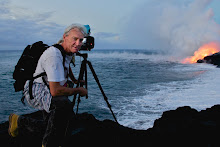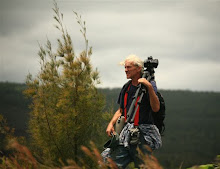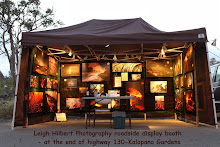 In this photo, taken last night at dusk, we are looking towards the southeast from the leading easterly front of advancing surface lava. In the distance we can make out some of the homes in Kalapana Gardens and the Hakuma Horst.(click image for a little bit bigger size. Those more distant homes are just under one mile from the flow front, the closest being approximately 2800-feet away(Peggy's qunset home), and about 3000-feet to the barricades of the Hawaii County lava-viewing site at roads end. The molten lava in the foreground is back-filling a low point of land; flowing northwest.
In this photo, taken last night at dusk, we are looking towards the southeast from the leading easterly front of advancing surface lava. In the distance we can make out some of the homes in Kalapana Gardens and the Hakuma Horst.(click image for a little bit bigger size. Those more distant homes are just under one mile from the flow front, the closest being approximately 2800-feet away(Peggy's qunset home), and about 3000-feet to the barricades of the Hawaii County lava-viewing site at roads end. The molten lava in the foreground is back-filling a low point of land; flowing northwest.And the image below shows the same view after dark an hour later. Notice how much higher the lava in the foreground is — that is what we refer to when we mention surface flow inflation (not the other magma chamber inflation); the molten lava beneath the quickly cooling crust thrusts lava higher off the ground in large pillowy shapes.


The flow front we see here is burning through one of the last sizable patches of forest before flooding out onto the flatter portions of the coastal plain, which it has now begun doing.

This lava is not flowing directly toward any of those houses or the end of the road; it is flowing in a filling-sprawling & inflating way- but as of last night, basically in a southerly direction with a southeast bent. Below is the photo I posted yesterday showing the perspective of this lava flow as seen from those homes:
 (Including the quonset-shaped home I mention above)
(Including the quonset-shaped home I mention above)I surveyed the lay-of-the-land and tried to guess where this lava may travel to if it continues being feed and progresses – not an easy call this time. That said, I think there is about a 40% chance this flow will reach onto and beyond the end of the road (where barricades are now), threatening the nearest home (Quonset house shown in yesterdays post) within the next ten days, making that a 60% chance it will flow on by and potentially threaten homes on the further end of Kalapana Gardens, near the Hakuma Horst, before reaching the sea.
This surface flow will likely begin sprawling across the lower coastal flats, filling low areas, pooling and inflating higher as it goes. Last July 14th, when the flow front was at this distance from the sea, this same sort of lava action decimated a vast amount of forest and burned one home before reaching the ocean eleven days later. We may see a similar scenario with this December flow; but Pele makes all those decisions around here. This lava seen here in these photos is east of both the July and November flows and tubes and the quarry, but will soon be intersecting them.
One big regulator of these flows is the magma reservoir pressure beneath the Kilauea Volcano. A strong and sustained rise or fall of pressure, as recorded by deformation monitors can greatly affect flow rates: low pressure (deflation) may slow or stall all or portions of the flow front, a rise (inflation) may increase all that activity. Currently the magma pressures are deflating:

There is at least a mile of active surface lava behind this leading edge, running way up the Pulama Pali, with some branches running far east of the other recently flowing lava tubes.

Go with the flow











No comments:
Post a Comment